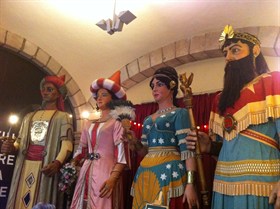The Giants of Barcelona
At the end of the Middle Ages, in Barcelona the giant Goliath and Saint Christopher, along with other monstrous animals, participated in the mystery plays of Corpus Christi. Even today, the historical procession of the Blessed Sacrament is preceded by the march of the giants and the parade of fantastic creatures. From the fifteenth century to the present day, however, many things have changed. Initially, only the giants and the animals in the Christian repertoire took part in the Corpus Christi procession of Barcelona. Over time, however, the biblical giants were replaced by new characters and the components of the bestiary have lost their original meaning. Today, in most cases, the giants belong to everyday life, and only a few of them still evoke the historical profiles of their biblical ancestors or gifts. Among them, we can mention the two Gegants de la Ciutat, which today, with the Aliga (the Eagle) are the holidays symbols of the Catalan capital. At the beginning of the fifteenth century, when the pair of giants had not yet been formed, the male impersonated the Philistine Goliath. Later, after the creation of the giantess, the two giants have been variously associated with the figures of Esther and Ahasuerus, and, under the Franco dictatorship, the Catholic Monarchs Ferdinand of Aragon and Isabella of Castile. Today, they are identified with Jaume I of Aragon and Yolanda of Hungary (Violant)Yolanda or Violant of Hungary (1215-1251) was the daughter of King Andrew II of Hungary and the Princess of Constantinople Yolanda de Courtenay. In 1235 she married King Jaume I of Aragon (1208-1276), thus becoming queen consort of his vast possessions: the kingdoms of Aragon, Valencia and Mallorca, the county of Barcelona, the lordship of Montpellier and other fiefs in Occitania. Among the couple’s children, were Peter III the Great (1239-1285), the King of Aragon and Valencia, and Jaume II of Majorca (1243-1311) King of Majorca and Lord of Occitan, land he inherited from his father.. Old and fantastic stories are part of the lineage of four other giants: Els Gegants del Pi (Elisanda and Mustafa) and Els Gegants de Santa Maria del Mar (King Solomon and the Queen of Sheba).
 During the Early Modern period, the giants of Barcelona have moved into diverse festive contexts, changing owners (City Hall and corporations before, associations and districts nowadays), forms and identities. Today we can see the result of this long transformation in the most important celebrations in towns, not only in the Corpus Christi ceremony (held in late June), but also in the feasts of the two patron saints of the city, Saint Eulalia (12 and 13 February) and the Mare de Deu de la Merce (Our Lady of Mercy). The second, created in the mid-nineteenth century, has become, over time, a major feast in Barcelona. Every year, on 22 to 25 September, during these celebrations expositions and impressive parades of giants and legendary monsters take place between the Plaça de Sant Jaume, the Rambla and the surroundings of the Cathedral (especially along the grand Via Laietana).
During the Early Modern period, the giants of Barcelona have moved into diverse festive contexts, changing owners (City Hall and corporations before, associations and districts nowadays), forms and identities. Today we can see the result of this long transformation in the most important celebrations in towns, not only in the Corpus Christi ceremony (held in late June), but also in the feasts of the two patron saints of the city, Saint Eulalia (12 and 13 February) and the Mare de Deu de la Merce (Our Lady of Mercy). The second, created in the mid-nineteenth century, has become, over time, a major feast in Barcelona. Every year, on 22 to 25 September, during these celebrations expositions and impressive parades of giants and legendary monsters take place between the Plaça de Sant Jaume, the Rambla and the surroundings of the Cathedral (especially along the grand Via Laietana).
